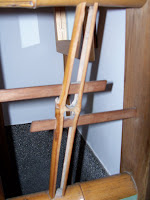.JPG)
Old Japan meets New Japan. The young people of the district have chosen a contemporary manga character as the theme for their giant lantern in this ancient ritual.
.JPG)
It's a bit complicated, but bear with me... Medama Oyaji is the father of the boy Kitaro, a manga created by the famous Shigeru Mizuki. Medama Oyaji was once a fully-formed adult who perished of a disease, only to be reborn out of his decayed body as an anthropomorphic version of his own eyeball. He enjoys staying clean, and is often seen bathing in a small bowl...

Not much left of his eye/head now. Strange they should choose to destroy a character they admire. Some politician in effigy might have been better. Wakarimasen.

These beautiful large lanterns above the shrine's archway weren't smashed.


After a day of carting these massive things all around Aboshi, these teams are exhausted, but they continue lifting, bouncing and swaying the illuminated
yatai into the night...



 Because of its very fine grain, bamboo is ideal for spoons, rice paddles and chopsticks.
Because of its very fine grain, bamboo is ideal for spoons, rice paddles and chopsticks.
































.JPG)
.JPG)
















